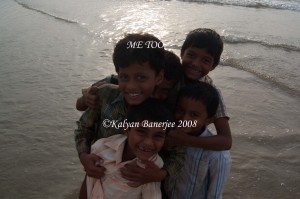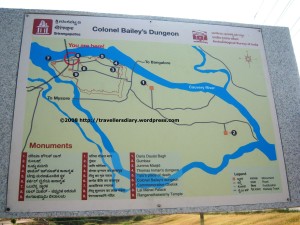Follow me on Twitter. Add me as a friend on at Orkut or Facebook . Visit my Flickr photostream.
This post has been published in Club Mahindra blog. This is my 3rd post on Gokarna. Here’s my 2nd post and 1st post.
About Gokarna: An ancient beach town in Uttara Kannada district of Karnataka, Gokarna has great religious significance as well. The town has 5 beaches – Gokarna, Kudle, OM, Half Moon and Paradise – in that order and with hills between the beaches. As such, it offers extremely good opportunity for beach treks. None of these beach treks surpass 30 minutes duration and provide exotic views of the sea from the hillocks. World seems to have stopped when you are here – beach hop, lay on the beach, jog, walk, eat at beach cafes, buy, drink, dance, write – do whatever but don’t rush. This is a place that rewards laziness. All these make Gokarna a great two day weekend getaway from Bangalore, Goa, Mumbai and Pune during Oct-Apr.
Each beach in Gokarna is a lazy man’s paradise. Stay and eat at a beach side hack/cafe/hotel/resort. Lie on the beach – on a bed-sheet with a hat over your face to avoid sun/eye-contact, or with the sun scorching your back. Or, read a book lying on a towel and in your bare minimum. And the best part, wear almost anything that you want (just that you have to wear something) – barmudas with sleepers, Alibaba pants and top, or a skirt of any shape and size.
There are five beaches in Gokarna – Gokarna, Kudle, Om, Half Moon and Paradise, in that order.
Gokarna Beach – It lies close to the town and is frequented by locals and tourists alike. The beach is close to the Mahabaleshwar Temple, a very old Lord Shiva temple that has an associated legend as well. At the beach, you can spot families, young and elderly couples, single and group travellers. It goes without saying – several fast food joints and the groundnut/balloon sellers adorn the shoreline. In the vicinity, you will find plenty of hotels, food joints and garments/puja shops. A word of caution here for tourists: Avoid wearing skimpy clothes in the area. Since the ancient temple is nearby, this part of Gokarna is more of a pilgrim town than a beach town. You wouldn’t want to be an eye-sore for the locals just for your choice of clothes.
Kudle Beach – Is mostly frequented by foreigners and is almost a kilometer long, pretty wide as well. This gives you ample space to engage in the usual beach games, bonfires etc. Rocks, and plenty of them, adorn the sea shore. You’d find foreign tourists (mostly, but some Indians as well) staying in the shacks – sleeping, eating, drinking and reading. I spotted the “Shantaram” being read atleast atleast thrice! King Fish delicacies are very tasty and are reasonably priced, in fact cheaper than most restaurants in Bangalore. The eateries play continental/Israeli music all the time. You could also beach trek from Kudle to Mahabaleshwar Temple.
OM Beach – This beach is around 20 minutes of an auto ride from the Gokarna bus stand. Certainly the best of the five Gokarna beaches, the beach derives its name from the Hindu religious symbol – OM, since its shape resembles that of the symbol. The ‘OM’ shape is pretty evident when you see the beach from the hillocks on the either side. However, the right side gives a better view than the left. Consequently, the picture you take would be mirror image of the OM symbol. The beach is the longest among the five beaches and is frequented by Indian and foreign tourists alike. You can stay at the Namaste Café which overlooks the OM Beach, or at any of the several shacks that are scattered around the beach. There is also the Swaswara resort as well, a hundred odd meters away from Om beach. There are three equidistant rocky patches at the beach. Two things you shouldn’t miss at OM – sitting atop each rock patch and the morning jog.
Half Moon Beach – It’s a tiny beach and can be reached by beach trekking from Om, or by paying INR 200 on a ferry boat. But the ferry ride wouldn’t allow you to spend much time at the beach. The beach has huge rocks as well. There’s a hut and you may as well get some food there. Once here lose yourself and merge with the tranquil surroundings.
Paradise Beach – The fifth and the last beach in the series, and it befits its name. You have to beach trek for about 20 min from Half Moon beach to reach Paradise beach. There are a couple of beach cafes as well.
Tips…
- Be careful while swimming, as the sea is shallow at some places and there are several cases of death due to drowning reported every year here.
- As usual, bargain hard with the sellers – beads sellers, clothes and accessories sellers, musical instruments sellers etc.
- Take mosquito repellent and a bed-sheet with you.
- Try beach trek – there are at least four options. If you can’t beach trek at all, you can see the beaches on a ferry boat – at INR 200 per head.
- Take your swimwear with you – there aren’t too many beaches in India where you can wear them without being ogled. So, don’t miss this opportunity.
- Don’t wear bikini at the Gokarna Beach – this may offend the local people and the police. But you may wear them at the other four beaches.
- Don’t miss the morning jog at OM beach.

























































